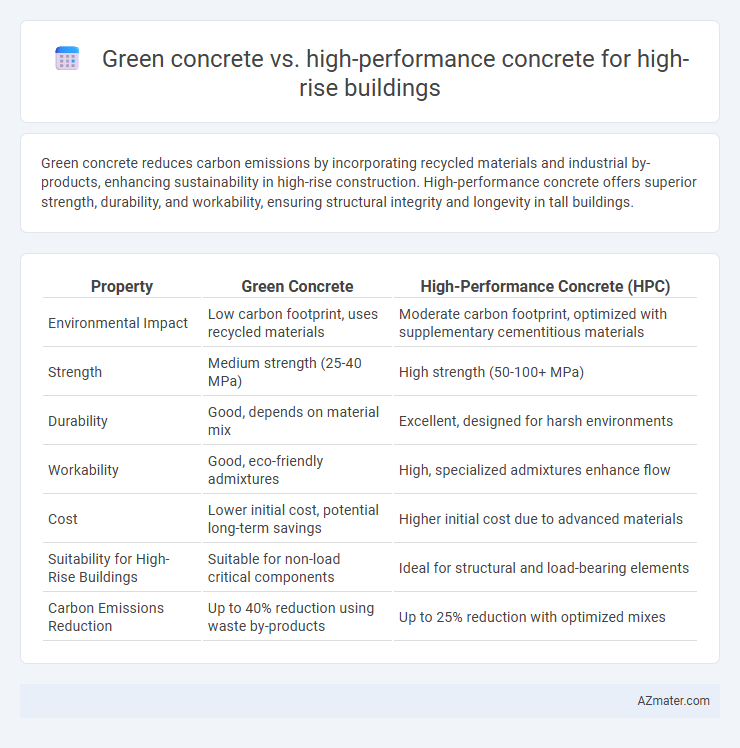Green concrete reduces carbon emissions by incorporating recycled materials and industrial by-products, enhancing sustainability in high-rise construction. High-performance concrete offers superior strength, durability, and workability, ensuring structural integrity and longevity in tall buildings.
Table of Comparison
| Property | Green Concrete | High-Performance Concrete (HPC) |
|---|---|---|
| Environmental Impact | Low carbon footprint, uses recycled materials | Moderate carbon footprint, optimized with supplementary cementitious materials |
| Strength | Medium strength (25-40 MPa) | High strength (50-100+ MPa) |
| Durability | Good, depends on material mix | Excellent, designed for harsh environments |
| Workability | Good, eco-friendly admixtures | High, specialized admixtures enhance flow |
| Cost | Lower initial cost, potential long-term savings | Higher initial cost due to advanced materials |
| Suitability for High-Rise Buildings | Suitable for non-load critical components | Ideal for structural and load-bearing elements |
| Carbon Emissions Reduction | Up to 40% reduction using waste by-products | Up to 25% reduction with optimized mixes |
Introduction to Green Concrete and High-Performance Concrete
Green concrete utilizes recycled materials and industrial byproducts to reduce environmental impact while maintaining adequate strength for high-rise buildings. High-performance concrete is engineered for superior strength, durability, and workability, often incorporating chemical admixtures and optimized aggregates to meet rigorous structural demands. Both types contribute to sustainable construction, with green concrete emphasizing eco-friendliness and high-performance concrete focusing on enhanced mechanical properties.
Key Material Components and Innovations
Green concrete utilizes recycled materials such as fly ash, slag, and recycled aggregates to reduce environmental impact, while high-performance concrete incorporates advanced admixtures like silica fume and superplasticizers to enhance strength and durability. Innovations in green concrete focus on carbon capture technologies and bio-based binders to lower CO2 emissions, whereas high-performance concrete advancements include ultra-high-strength formulations and improved curing methods to withstand extreme loads and environmental conditions. Both materials emphasize optimizing the cementitious matrix but differ in their sustainability goals and mechanical performance priorities for high-rise construction.
Environmental Impact and Sustainability
Green concrete significantly reduces carbon emissions by incorporating recycled materials and industrial by-products like fly ash and slag, enhancing sustainability for high-rise buildings. High-performance concrete, while offering superior strength and durability, often relies on traditional cement compositions that produce higher environmental footprints. Choosing green concrete supports reduced energy consumption and waste, making it the preferred environmentally conscious option for sustainable urban development in high-rise construction.
Structural Strength and Load-Bearing Capacity
Green concrete incorporates recycled materials and industrial by-products, offering sustainable benefits while maintaining adequate structural strength for high-rise buildings. High-performance concrete (HPC) exhibits superior compressive strength, typically exceeding 70 MPa, and enhanced load-bearing capacity, making it ideal for critical structural components in tall structures. The enhanced durability and mechanical properties of HPC provide greater resistance to environmental stresses, ensuring long-term stability in high-rise construction.
Durability and Longevity in High-Rise Applications
Green concrete incorporates recycled materials and supplementary cementitious components, enhancing sustainability while providing adequate durability for high-rise buildings by reducing permeability and improving resistance to chemical attack. High-performance concrete (HPC) offers superior strength and durability through carefully controlled mix design, enabling better resistance to environmental stresses, freeze-thaw cycles, and carbonation, which is critical for longevity in tall structures. In high-rise applications, HPC typically outperforms green concrete in terms of long-term durability metrics, but combining green concrete principles with HPC technology can optimize both sustainability and structural longevity.
Workability and Construction Efficiency
Green concrete enhances workability through the use of supplementary cementitious materials like fly ash and slag, which improve mixture cohesion and reduce water demand, resulting in easier placement and reduced segregation. High-performance concrete offers superior workability with tailored admixtures, maintaining flowability under high-strength requirements, enabling faster construction cycles and less labor-intensive handling. Both concretes optimize construction efficiency by minimizing curing times and facilitating rapid strength gain, critical for the tight schedules of high-rise building projects.
Cost Analysis and Economic Considerations
Green concrete offers lower material costs by incorporating industrial by-products like fly ash and slag, reducing reliance on expensive Portland cement, which can lead to significant savings in large-scale high-rise projects. High-performance concrete, while more expensive due to advanced admixtures and superior mechanical properties, provides long-term economic benefits through enhanced durability, reduced maintenance, and extended service life of high-rise structures. Evaluating initial costs against lifecycle expenditures is critical for developers, with green concrete appealing to sustainable budget-conscious projects, and high-performance concrete favored when structural demands and performance longevity are prioritized.
Fire and Thermal Resistance Properties
Green concrete incorporates recycled materials and industrial by-products, enhancing its thermal insulation properties and reducing heat transfer during fires, which improves fire resistance in high-rise buildings. High-performance concrete (HPC) delivers superior mechanical strength and durability, with additives that enhance fire and thermal resistance by limiting spalling and maintaining structural integrity under extreme temperatures. Both materials offer unique fire and thermal resistance benefits, but HPC provides more reliable performance in high-rise building applications requiring rigorous safety standards.
Case Studies of High-Rise Buildings
Case studies of high-rise buildings demonstrate that green concrete significantly reduces carbon emissions and improves sustainability without compromising structural integrity, as evidenced by the Pearl River Tower in China. High-performance concrete, utilized in the Burj Khalifa, exhibits superior strength and durability, enabling extreme height and load-bearing capacity. Comparative analyses reveal green concrete prioritizes environmental impact, while high-performance concrete emphasizes mechanical performance for skyscraper construction.
Future Trends and Recommendations
Green concrete incorporating recycled materials and low-carbon additives is gaining traction for sustainable high-rise construction, reducing environmental impact without compromising structural integrity. High-performance concrete (HPC) continues to evolve with advancements in nanotechnology and enhanced admixtures, offering superior strength, durability, and faster curing times crucial for tall building resilience. Future trends favor hybrid approaches combining green concrete's sustainability with HPC's mechanical excellence, recommending ongoing research into bio-based binders and optimized mix designs for scalable, eco-efficient high-rise projects.

Infographic: Green concrete vs High-performance concrete for High-rise building
 azmater.com
azmater.com